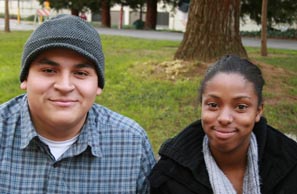Enrollment: History sees gender disparity

Senior business major Diejo Mejia hangs out with sophomore child development major Shawnica Lewis in between classes by a tree outside of the University Union.:
February 14, 2008
Enrollment of male students in the California State University and University of California campuses is declining. But how real is this drop?
Ed Mills, associate vice president for Enrollment and Student Support at Sacramento State, said over the last decade, male enrollment at Sac State remained at about 42.5 percent of the student population, though he heard reports stating that male enrollment dropped at CSU and UC systems.
“Our campus is very diverse, and this is a reflection of the Sacramento community,” Mills said.
During the 1960s and 70s, college campuses were predominantly male, perhaps as high as 70 percent, Mills said. As more female students began to seek college education, the statistics have changed. The result is that male enrollment has not dropped. Rather, female enrollment has increased.
About 45 percent of the students enrolled nationally in 1991 were male, according to the National Center for Education Statistics (NCES). As of 2005, the last year that numbers were reported, total student enrollment increased, while male enrollment decreased to 42.6 percent.
Statistically, this is a negligible change in male enrollment. Female enrollment has increased while male enrollment remains about the same.
Kevin Warring, junior engineering major, said male students may be going to trade schools.
“I barely see any girls in my engineering classes,” Warring said. “Girls take easier majors, like business communications.”
Elhum Zaker, freshman psychology and communications major, said males change schools frequently.
“Girls are more serious about school. Guys are more interested in screwing around,” Zaker said.
Ryan McGaugh, sophomore mechanical engineering major, had a different perspective.
“A lot of men feel like they have obligations,” McGaugh said. “A lot of guys drop out for work. The media is part of the problem. The media image is distracting. The sitcom ‘Friends’ is a great example. You have a bunch of guys who don’t work, sitting around in coffee shops and living in nice apartments in New York. It’s not reality, but people make assumptions that it is supposed to be that way.”
Zaker noticed there still are not a lot of women in politics or running companies. She said that it has little to do with education.
“Men are more persuasive. In jobs, like sales, men are more successful because they negotiate aggressively. Woman should not be in politics, because they break under pressure,” Zaker said.
McGaugh said the workforce hasn’t changed for different reasons.
“The CEOs are the same people they have always been: white men,” he said. “There is still an old, sexist attitude. More men are probably going into blue-collar, service-type work than they used to. Most of my teachers are men. Women are probably taking the white-collar jobs: management, healthcare, those types of jobs.”
A recent article by John Perez, vice Chairman of the California Postsecondary Education Commission, and Theresa Montaño, former president of United Teachers Los Angeles, published an article in the Los Angeles Daily News discussing the gender gap in the CSU and UC systems.
Perez and Montaño insisted that the gender gap exists. The authors said that union jobs, once a bastion for the working class, were sent overseas and no longer provide the “high-paying jobs” that males lacking a college education often would rely on. Based off of the article alone, there is no source for this piece of information.
Union Jobs Clearinghouse, the online union job search website, currently lists hundreds of positions available in the northern California and Sacramento area. Throughout California, trade unions have available openings in apprenticeship programs and educational programs, in which persons who graduated high school and over the age of 18 can learn a trade while being paid to work.
Perez and Montaño also said educational strategies in elementary and high school could be producing a disadvantage for male students.
The article also states that differences in methods of learning have been ignored in order to tailor education to women. According to a study conducted by Linn and Hyde in 1991, differences in learning patterns between boys and girls are negligible, and if present at all, are declining. They also identified that if differences do exist, males have a slight advantage.
More recent research, conducted as part of the “No Child Left Behind Act,” showed that there are virtually no differences in learning styles between boys and girls.
The media-proposed drop in male enrollment does not appear to be supported by statistics, and does not seem to be occurring at Sac State. Student populations on campus have not changed and are not expected to change in the future.
Derek Fleming can be reached at [email protected].




























































































































